Table of Contents
Brands and marketers that have a documented mission for their content marketing strategy, consistently report greater success (about 3X) than those who don’t have a clearly defined mission. (Source: CMI)
By creating a mission, you are creating the driving force behind any and all content you create.
It provides a compass-like point of reference for anyone working on the content strategy and acts as a guiding light to ensure topics remain focused on the brand, audience and goals.
Over time this ensures relevance, topical authority and attracting the right target audience to your brand.
The process we will walk through is as follows:
- Identifying the objective(s) of the content strategy, linked to marketing and business objectives
- Who the content strategy is designed to engage (the audience)
- The content strategy mission statement
- The positioning / angle connected to the brand
- How and where to use your content marketing mission statement
This post intentionally doesn’t jump straight to crafting the mission statement.
Why?
Because it’s important that all the components work together for a more authentic and impactful mission statement.
Let’s dive in.
Connecting the content marketing mission to business and marketing objectives
Business objectives are high-level and are assigned to the entire company.
Business objective examples:
- Increase revenue by 20% in the next financial year
- Expand into two new markets by the end of the year
- Reduce operational costs by 15% in the next quarter
Marketing objectives are desired outcomes that marketing needs to achieve in order for the business to be on track in achieving its goals. Marketing’s contribution to the business objectives.
Marketing objective examples:
- Increase lead generation by 25% in the next quarter from digital
- Increase website conversion rate by 10% by the end of the year
- Increase brand awareness by 20% in the next six months
Next up is the objectives for your content marketing strategy
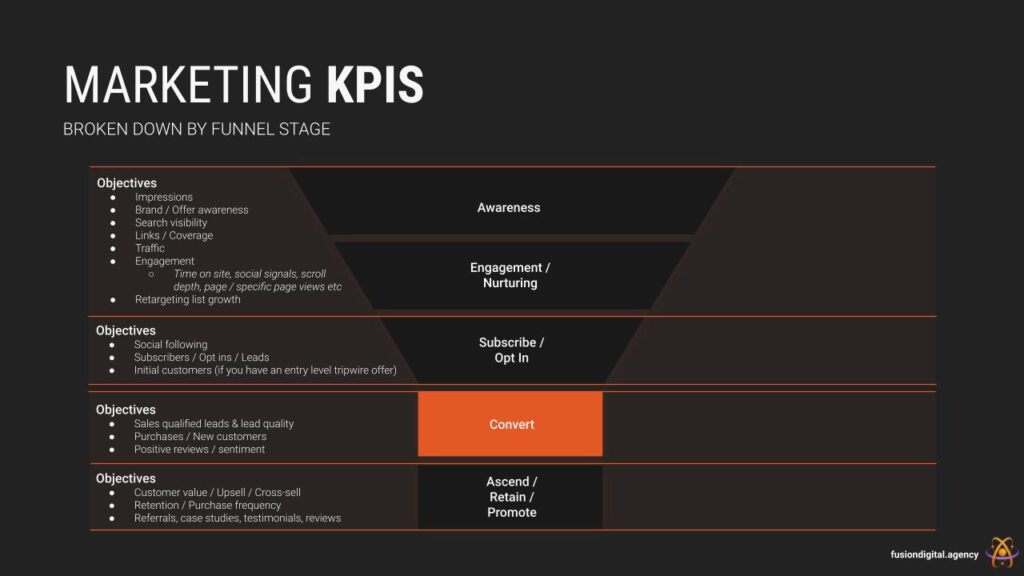
The next level down is what the marketing channel(s) needs to deliver in order for ‘marketing’ to achieve its objectives.
Example content marketing and/or SEO objectives:
- Increase website traffic by 20% this financial year
- Generate 500 new subscribers this quarter
- Improve non-brand keyword visibility to 100 page 1 positions
- Establish credibility through 10 thought leadership Digital PR placements
With the business, marketing and channel objective(s) in place, you now have everything aligned and a specific reason (objective) for creating a content marketing strategy.
IMPORTANT: You might not know what the objectives and key results should be at this stage, or you might not be very confident in setting them. Just put a stake in the ground and set the best OKRs you can.
This is important because it gives you focus. You know what you are aiming for, so you know if you are behind or ahead and what success looks like.
You also know what the gap is from where you are now, to where you want to get to.
Knowing the gap, allows you to put together the content marketing strategy and associated key results needed from it, in order to close the gap and achieve the objectives.
The OKRs then act as your compass as you navigate the strategy and inform what you need to do on an ongoing basis to close the gap.
Reassess every month and quarter and if it turns out you set goals that are way too high or too low, then you should adjust based on data and a more informed position.
—
So that being said, decide – based on your available resources, the business and marketing objectives – what you think the content marketing strategy can deliver.
If it’s a leads objective, then how many leads?
Work backwards if you need to and assign supporting objectives:
So how much traffic do you need to generate to achieve the leads goal? How much more visibility do you think you need from SEO? How much content do you need to produce and how many links do you think you need to generate?
Make sure KPIs are agreed and that tracking is configured for effective measurement, analysis and reporting.
Consider the marketing funnel, customer journey, the different KPIs and content that might be required at each stage.
Let’s finish this section with an example:
Business OKRs:
Objective: Increase overall business revenue
Key Results:
- Increase quarterly revenue by 15%
- Acquire 200 new customers in the quarter
- Increase average transaction value by 10%
Marketing OKRs:
Objective: Boost customer acquisition through marketing efforts
Key Results:
- Generate 1000 new leads through marketing campaigns
- Convert 20% of the new leads into customers
- Increase website traffic by 30%
Content Marketing OKRs:
Objective: Create high-performing content that drives lead generation
Key Results:
- Publish 20 new pieces of content (e.g., blog posts, videos, infographics) per month
- Increase average page views per new content piece by 50%
- Generate 200 new leads from content marketing efforts per month
In this example, you can see how each department’s OKRs contribute to the overall business OKRs.
The marketing department is tasked with generating new leads and converting them into customers, which contributes to the business’s goal of acquiring new customers and increasing revenue.
The content marketing team, specifically, is tasked with creating content that drives lead generation, thus supporting the marketing department’s OKRs.
Remember, OKRs should be specific, measurable, achievable, relevant, and time-bound (SMART).
They should also be aligned with the overall business goals to ensure that all departments are working towards the same objectives.
Persona or ‘Value Profile’? How to choose the right target audience for your content strategy
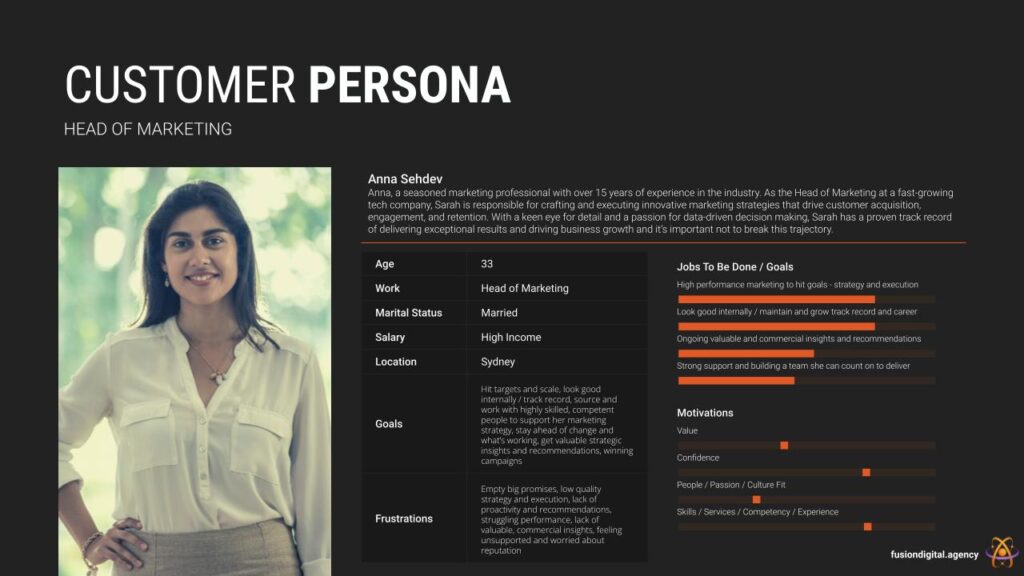
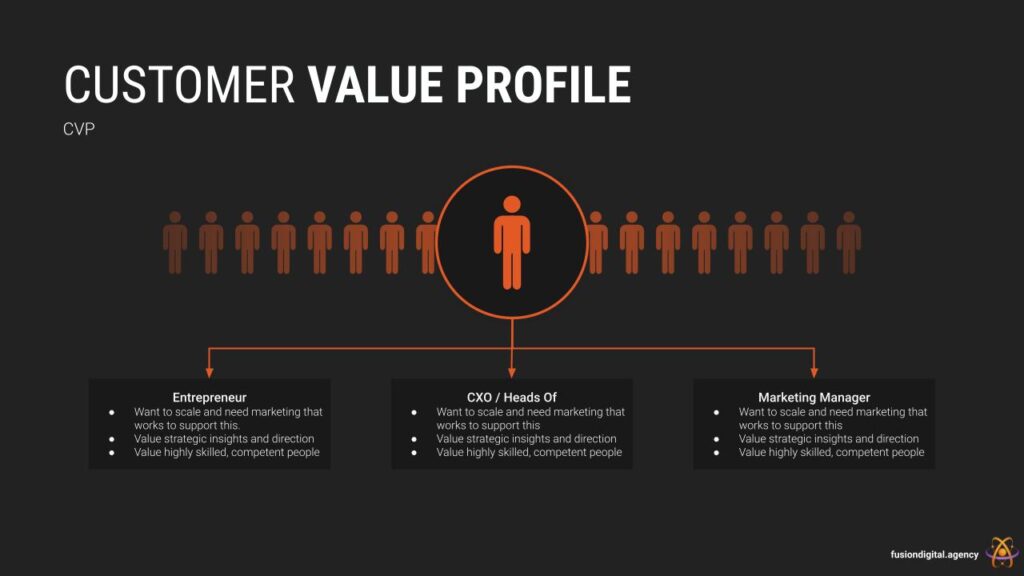
The first part of the content marketing mission is the WHO.
There’s a few ways to approach this and the objectives and resources will factor into your decision making.
If the objective you are working towards is aimed at a specific persona, or your business only has a very narrow audience (ie 1 or 2 personas), then it makes sense to create your content strategy and mission statement specifically for this persona.
In other cases, you might be in a large enterprise organisation with deep pockets, internal and external teams. In this case, you might have several personas, but with the resources to target them all with different content strategies, each with different mission statements.
In most cases however, you will be looking to create a content marketing strategy [with limited resources] to achieve more broad objectives that span across different / all audience segments… but how is this possible?
By using a customer value profile as the ‘WHO’ in your content marketing mission statement.
To do this, instead of looking at different personas, look for the common values that they share.
By this, we mean the common things that they all care about the most.
Examples of things that might be common to all personas, regardless of demographics and even psychographics:
- Job(s) to be done
- Pain point
- Desired end result
- Aspirational identity [probably in a particular setting or moment in life]
Also think about the intersection between what your product or service does and what the audience cares about.
Example Red Bull:
Red Bull’s content is centred around the intersection between their product providing them with energy and alertness and the audience’s interest for high adrenaline activities, extreme sports, a fast-paced lifestyle etc”
What’s something (or a few things) that they all share and care about, that your content strategy can help them with and unite them around the mission?
For Fusion, our audience consists of:
- Marketing Managers
- Marketing Directors
- Heads of Marketing
- Entrepreneurs
- CXOs
- Other related roles
- Mixture of Male / Female / Other
- Age ranges late 20s – late 50s
- Lots of different sized organisations
- Some with sizeable internal teams and multiple agencies, others with just a couple internal marketing people and us as the sole agency
We could go on and on breaking down personas, and the people are all very different… but we only have limited capacity for content marketing.
So what are the common values? What do they all care about?
- Hitting the ever-moving target that is marketing that works
- Joining the dots, making connections and drawing insights from data and across channels for more informed decision making and reporting
- They also care about things like culture fit, service, transparency etc, but this alone doesn’t make for a comprehensive content strategy
With business, marketing and content marketing objectives in place and the target audience or value profile identified, you are informed and ready to craft the mission statement for your content strategy.
Hack to get you moving: If you’re getting hung up at this point with common values, personas, who to target, how to approach etc… just base things on your ideal customer profile and run with that. Can always adjust later if need be.
Final important note:
With content marketing, your audience won’t only be made up of your target customers. It will and should include people who will recommend you to your target customers.
In some cases, it’s the word of mouth audience rather than your target customer audience that will be the driving force in the performance of your content strategy (by spreading your content and recommending you through word of mouth).
Everyone is keen to dive into the execution of the content marketing strategy, but the WHY needs to come before the WHAT.
Here’s the formula for crafting an effective and clear content marketing mission statement
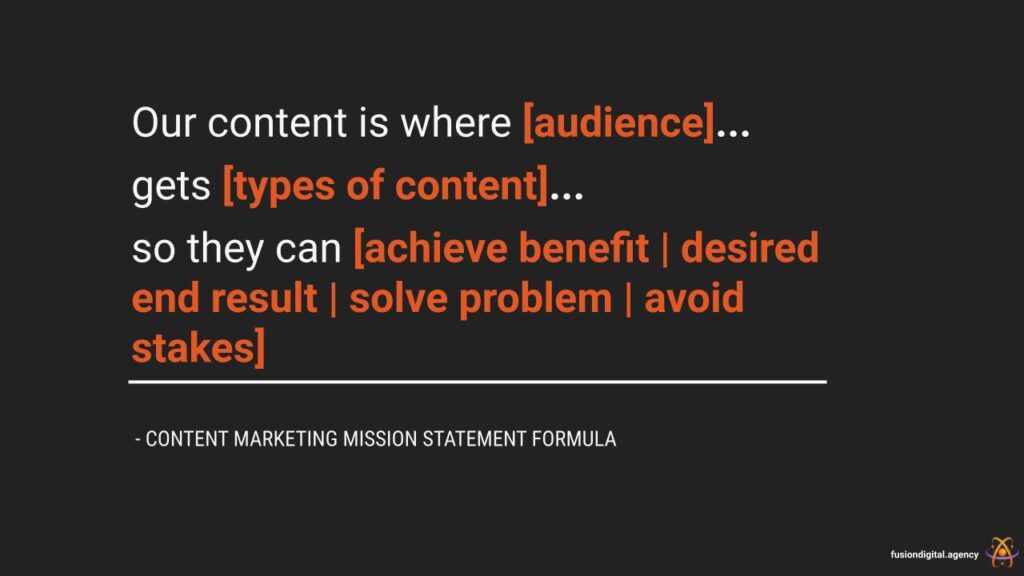
Where [audience] gets [X] so they can achieve benefit/desired end result | solve problem | avoid stakes etc [Y]
More simply:
Our content is where [audience X] gets [information Y] that offers [benefit Z].
Note: ‘Content’ can mean any channel and any format.
You are defining who you are talking to, what you are talking about and why they should pay attention.
The content marketing mission statement will then act as the point of reference for every decision you or anyone else working on your content strategy takes. If an idea, campaign or piece of content doesn’t fit with the mission, it’s out.
Here’s our content marketing mission statement for Fusion:
Content that helps marketing professionals to consistently win through comprehensive tactical and strategic guides, insights, news, resources, case studies, commentary, expert opinions and inspiration.
Strategically join the dots, stay ahead of change and make better decisions while focusing on what matters to hit the moving target that is marketing that works.
- The core audience target (The Who): Marketing professionals
- Notice the use of the word ‘professionals’ vs specific job titles. The other audience segments should identify or at least relate to the umbrella of ‘marketing professionals’ and know they are in the right place
- The ‘core audience’ definition just needs to be a uniting factor – in our case, it’s ‘marketing’ that unites the different roles
- What will be delivered to the audience (The What): Comprehensive tactical and strategic guides, insights, news, resources, case studies, commentary, expert opinions and inspiration.
- The outcome for the audience (The Why They Should Care): Strategically join the dots, stay ahead of change and make better decisions while focusing on what matters to hit the moving target that is marketing that works.
Content marketing mission statement examples:
Econsultancy.com
“To curate a definitive guide to digital transformation that helps time-poor senior executives understand how it could add value to their business.”
—
Red Bull Media House
“On a mission to inspire with ‘beyond the ordinary’ stories – both direct-to-consumer and through partnerships.
With a focus on sports, culture and lifestyle content, Red Bull Media House offers a wide range of premium media products across TV, mobile, digital, audio, and print. Red Bull Media House produces and licenses a broad selection of global live broadcast events, compelling and inspirational local storytelling with original short and long-form programming as well as feature films from around the world.”
—
Inc.com
“Welcome to Inc.com, the place where entrepreneurs and business owners can find useful information, advice, insights, resources and inspiration for running and growing their businesses.”
Decide on the positioning or angle to connect content with brand, cut through the noise and stand out from the crowd
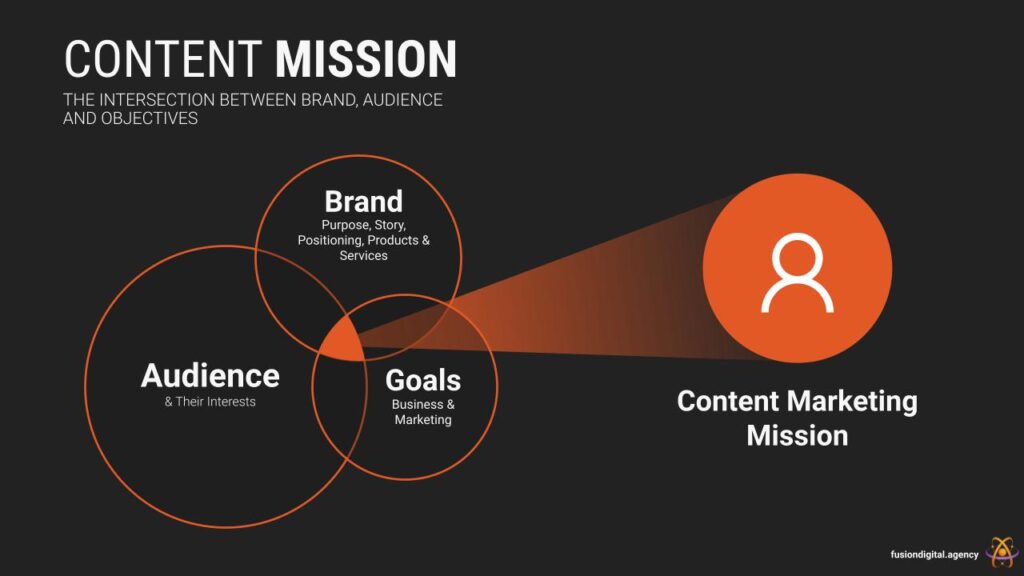
Your brand should have a purpose for existing – your why (think Golden Circle by Simon Sinek) and a clear positioning in the market. Your brand content strategy should reflect or be in line with this. It’s the reason someone might prefer your brand over a competitor.
Note: Positioning can be changed and brands reposition all the time, so don’t get hung up on this.
Brand positioning is a big topic on its own, but for the purposes of this article, a broad way of looking at it could be defined as positioning against:
- A ‘villain’
- The status quo
- A change that’s happened
- A current / inferior way of doing things
- A problem
- etc
The reason for bringing this up, is when you are putting together your content strategy and mission statement, don’t forget about the purpose and positioning of the brand and the brand story.
Use the brand positioning and mission to inform your content marketing mission. Think about how you can align the content strategy with the brand purpose and positioning.
What unique value or angle can you apply to your content strategy that relates to your brand purpose and/or positioning and is different to competitors?
Do this, and the content strategy direction and the angles you use when creating the content, will have more cut through and should align much closer to the overall brand… which should lead to greater performance across all marketing activity and channels.
This is important. Content is a huge builder of the brand.
The Fusion brand purpose is Helping People Win and our positioning is about breaking silos and working together to better achieve marketing that works… and if you deliver marketing that works, our clients win, we win, our team wins etc.
It’s all connected – hence the name: Fusion.
Winners Work Together. Winners Work With Fusion.
So back to the outcome part of the mission, you can see that ‘strategically join the dots’ is a key part of the content marketing mission and positioning, with undertones of winning.
- The outcome for the audience (The Why They Should Care): Strategically join the dots, stay ahead of change and make better decisions while focusing on what matters to hit the moving target that is marketing that works.
Where to put your content marketing mission statement and how to make it part of the fabric of your company
Where your audience can see it.
You want to place your content marketing mission statement in key places where your audience will go to learn more about you and consume your content.
Places like:
- Your blog home page
- Your YouTube channel
- Your social media bios
- Email newsletter sign ups, footers and signatures (even a condensed version)
- Printed content
Where your team can see it.
It’s important that anyone working on the content strategy knows what the mission is, where to access it if required and keeps it front of mind as they work on the content strategy.
With that in mind, you might want to consider:
- Employee onboarding experience
- Learning management system / company intranet / Wiki or equivalent
- On relevant templates the team use
- As a reference point for feedback, recognition and constructive criticism
Do you have a content marketing mission statement?
If not, you could be missing out on up to 3X the performance from your content strategy.
Improve focus, consistency and performance from your content strategy, your digital marketing agency, your in-house team and anyone who works with you in the future.
Round up your team and book a brainstorming session to get it documented and rolled out.
Reach out if you have any questions and we’ll be happy to help.
Learn Content Marketing
 How To Create An SEO Content Strategy (In-Depth Guide)
How To Create An SEO Content Strategy (In-Depth Guide)
This step-by-step guide shows you exactly how to create a high performing SEO content strategy. This is how…
Read More
 How To Craft A Content Marketing Mission Statement And Why It’s ‘Mission’ Critical
How To Craft A Content Marketing Mission Statement And Why It’s ‘Mission’ Critical
Learn how to craft a clear and effective content marketing mission statement and why it can 3X your…
Read More
 Ultimate Step-By-Step Guide To Creating A Winning Brand Content Strategy Like The Iconic Brands (Coke, Dove, Red Bull And More)
Ultimate Step-By-Step Guide To Creating A Winning Brand Content Strategy Like The Iconic Brands (Coke, Dove, Red Bull And More)
Want to make some waves with your brand? You need a winning brand content strategy. This is NOT the…
Read More
 Killer Content Starts Here: Mastering Audience Research
Killer Content Starts Here: Mastering Audience Research
This is a complete guide to conducting killer audience research. Learn how to collect the right information and…
Read More



